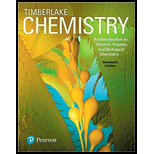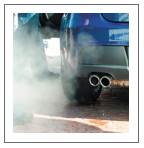
Concept explainers
Automobile exhaust is a major cause of air pollution. One pollutant is the gas nitrogen oxide, which forms from nitrogen and oxygen gases in the air at the high temperatures in an automobile engine. Once emitted into the air, nitrogen oxide reacts with oxygen to produce nitrogen dioxide, a reddish brown gas with a sharp, pungent odor that makes up smog. One component of gasoline is heptane, C7H16, a liquid with a density of 0.684 g/mL. In one year, a typical automobile uses 550 gal of gasoline and produces 41 lb of nitrogen oxide. (7.4, 7.8, 8.6)
a. Write balanced chemical equations for the production of nitrogen oxide and nitrogen dioxide.
b. If all the nitrogen oxide emitted by one automobile is converted to nitrogen dioxide in the atmosphere, how many kilograms of nitrogen dioxide are produced in one year by a single automobile?
c. Write a balanced chemical equation for the combustion of heptane.
d. How many moles of gaseous CO2 are produced from the gasoline used by the typical automobile in one year, assuming the gasoline is all heptane?
e. How many liters of carbon dioxide at STP are produced in one year from the gasoline used by the typical automobile?

Two gases found in automobile exhaust are carbon dioxide and nitrogen oxide.
Trending nowThis is a popular solution!

Chapter 9 Solutions
Chemistry: An Introduction to General, Organic, and Biological Chemistry (13th Edition)
- Hydrogen peroxide is used as a cleansing agent in the treatment of cuts and abrasions for several reasons. It is an oxidizing agent that can directly kill many microorganisms; it decomposes on contact with blood, releasing elemental oxygen gas (which inhibits the growth of anaerobic microorganisms); and it foams on contact with blood, which provides a cleansing action. In the laboratory, small quantities of hydrogen peroxide can be prepared by the action of an acid on an alkaline earth metal peroxide, such as barium peroxide: BaO2(s)+2HCl(aq)H2O2(aq)+BaCl2(aq) What mass of hydrogen peroxide should result when 1.50 g barium peroxide is treated with 25.0 mL hydrochloric acid solution containing 0.0272 g HCI per mL? What mass of which reagent is left unreacted?arrow_forwardThe space shuttle environmental control system handles excess CO2 (which the astronauts breathe out; it is 4.0% by mass of exhaled air) by reacting it with lithium hydroxide, LiOH, pellets to form lithium carbonate, Li2CO3, and water. If there are seven astronauts on board the shuttle, and each exhales 20. L of air pee minute, how long could clean air be generated if there were 25,000 g of LiOH pellets available for each shuttle mission? Assume the density of air is 0.0010 g/mL.arrow_forwardEthanol, C2H5OH, is a gasoline additive that can be produced by fermentation of glucose. C6H12O62C2H5OH+2CO2 (a) Calculate the mass (g) of ethanol produced by the fermentation of 1.000 lb glucose. (b) Gasohol is a mixture of 10.00 mL ethanol per 90.00 mL gasoline. Calculate the mass (in g) of glucose required to produce the ethanol in 1.00 gal gasohol. Density of ethanol = 0.785 g/mL. (c) By 2022, the U. S. Energy Independence and Security Act calls for annual production of 3.6 1010 gal of ethanol, no more than 40% of it produced by fermentation of corn. Fermentation of 1 ton (2.2 103 lb) of corn yields approximately 106 gal of ethanol. The average corn yield in the United States is about 2.1 105 lb per 1.0 105 m2. Calculate the acreage (in m2) required to raise corn solely for ethanol production in 2022 in the United States.arrow_forward
- You take 1.00 g of an aspirin tablet (a compound consisting solely of carbon, hydrogen, and oxygen), burn it in air, and collect 2.20 g CO2 and 0.400 g H2O. You know that the molar mass of aspirin is between 170 and 190 g/mol. Reacting 1 mole of salicylic acid with I mole of acetic anhydride (C4H6O3) gives you 1 mole of aspirin and 1 mole of acetic acid (C2H4O2). Use this information to determine the molecular formula of salicylic acid.arrow_forwardPropane, C3H8, is the fuel of choice in a gas barbecue. When burning, the balanced equation is C3H8+5O23CO2+4H2O a What is the limiting reactant in cooking with a gas grill? b If the grill will not light and you know that you have an ample flow of propane to the burner, what is the limiting reactant? c When using a gas grill you can sometimes turn the gas up to the point at which the flame becomes yellow and smokey. In terms of the chemical reaction, what is happening?arrow_forwardMany cereals are made with high moisture content so that the cereal can be formed into various shapes before it is dried. A cereal product containing 58% H2O by mass is produced at the rate of 1000. kg/h. What mass of water must be evaporated per hour if the final product contains only 20.% water?arrow_forward
- 4.69 The pictures below show a molecular-scale view of a chemical reaction between H2 and CO to produce methanol, CH3OH. The box on the left represents the reactants at the instant of mixing, and the box on the right shows what is left once the reaction has gone to completion. Was there a limiting reactant in this reaction? If so, what was it? Write a balanced chemical equation for this reaction. As usual, your equation should use the smallest possible whole number coefficients for all substances.arrow_forwardSilicon is produced for the chemical and electronics industries by the following reactions. Give the balanced equation for each reaction. a. SiO2(s)+C(s)arefurnaceElectricSi(s)+CO(g) b. Liquid silicon tetrachloride is reacted with very pure solid magnesium, producing solid silicon and solid magnesium chloride. c. Na2SiF6(s) + Na(s) Si(s) + NaF(s)arrow_forwardBacterial digestion is an economical method of sewage treatment. The reaction is an intermediate step in the conversion of the nitrogen in organic compounds into nitrate ions. What mass of bacterial tissue is produced in a treatment plant for every 1.0 104 kg of wastewater containing 3.0% NH4+ ions by mass? Assume that 95% of the ammonium ions are consumed by the bacteria.arrow_forward
- Write the balanced chemical equation for the complete combustion of adipic acid, an organic acid containing 49.31% C, 6.90% H, and the remainder O, by mass.arrow_forwardThe sugar sucrose, which is present in many fruits and vegetables, reacts in the presence of certain yeast enzymes to produce ethanol and carbon dioxide gas. Balance the following equation for this reaction of sucrose. C12H22O11(aq) + H2O(l) C2H5OH(aq) + CO2(g)arrow_forwardColorful fireworks often involve the decomposition of barium nitrate and potassium chlorate and the reaction of the metals magnesium, aluminum, and iron with oxygen. (a) Write the formulas of barium nitrate and potassium chlorate. (b) The decomposition of solid potassium chlorate leads to the formation of solid potassium chloride and diatomic oxygen gas. Write an equation for the reaction. (c) The decomposition of solid barium nitrate leads to the formation of solid barium oxide, diatomic nitrogen gas, and diatomic oxygen gas. Write an equation for the reaction. (d) Write separate equations for the reactions of the solid metals magnesium, aluminum, and iron with diatomic oxygen gas to yield the corresponding metal oxides. (Assume the iron oxide contains Fe3+ ions.)arrow_forward
 Introductory Chemistry: A FoundationChemistryISBN:9781337399425Author:Steven S. Zumdahl, Donald J. DeCostePublisher:Cengage Learning
Introductory Chemistry: A FoundationChemistryISBN:9781337399425Author:Steven S. Zumdahl, Donald J. DeCostePublisher:Cengage Learning
 Chemistry: An Atoms First ApproachChemistryISBN:9781305079243Author:Steven S. Zumdahl, Susan A. ZumdahlPublisher:Cengage Learning
Chemistry: An Atoms First ApproachChemistryISBN:9781305079243Author:Steven S. Zumdahl, Susan A. ZumdahlPublisher:Cengage Learning ChemistryChemistryISBN:9781305957404Author:Steven S. Zumdahl, Susan A. Zumdahl, Donald J. DeCostePublisher:Cengage Learning
ChemistryChemistryISBN:9781305957404Author:Steven S. Zumdahl, Susan A. Zumdahl, Donald J. DeCostePublisher:Cengage Learning Chemistry: The Molecular ScienceChemistryISBN:9781285199047Author:John W. Moore, Conrad L. StanitskiPublisher:Cengage Learning
Chemistry: The Molecular ScienceChemistryISBN:9781285199047Author:John W. Moore, Conrad L. StanitskiPublisher:Cengage Learning Chemistry by OpenStax (2015-05-04)ChemistryISBN:9781938168390Author:Klaus Theopold, Richard H Langley, Paul Flowers, William R. Robinson, Mark BlaserPublisher:OpenStax
Chemistry by OpenStax (2015-05-04)ChemistryISBN:9781938168390Author:Klaus Theopold, Richard H Langley, Paul Flowers, William R. Robinson, Mark BlaserPublisher:OpenStax





